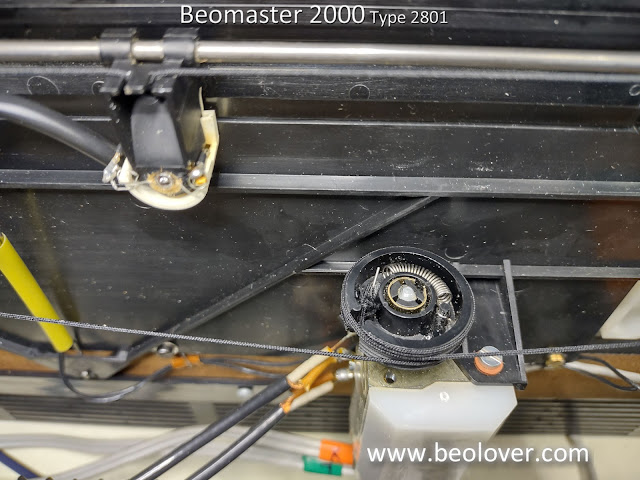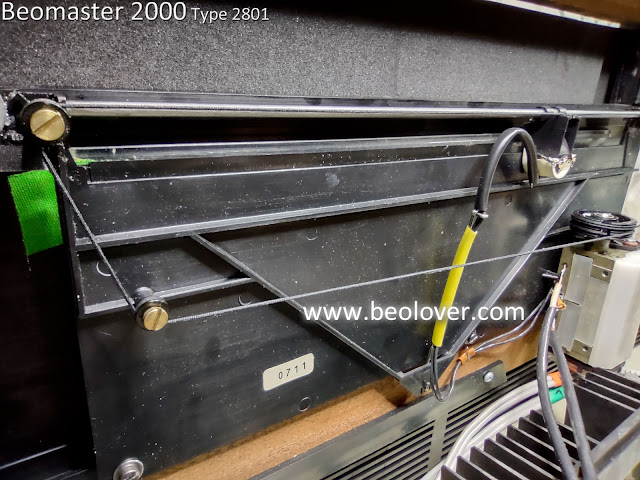I left off the last Beolover Blog post on the Beomaster 2000 (Type 2801) with the key voltages checked and the amplifier working. The Beomaster display lamps were in need of replacement. Some were burned out. I also found a badly frayed spot on the tuning dial cord. Both the lamps and the dial cord were items I didn't have on hand and had to order.
Those are here now and I started in on the replacement.
I decided to tackle the dial cord first. It seemed the most challenging based on the service manual instructions.
I received a very nice radio dial cord in black from Bob's Antique Radio & Electronics.
The dial cord he supplies is 0.028 inch diameter, non-stretch nylon cord with a fiberglass core.
That is 44 and 7/8 inches.
The old, frayed cord has knots on both ends that connect the spring mechanism that secures the cord to the tuning dial pulley. Having not restrung a dial cord before I did some research on other radio DIY repairs. I decided the best way for me to go was to make a replacement cord so that I have a knot on each end that, when stretched, measure 44 7/8 inches (114 cm) from the apex of one knot loop to the other.
The type of knot I selected is what is called a "perfection loop" knot.
There are probably better instructional diagrams for this type of knot but I like this one because it shows the apex where I am making my 114 centimeter measurement from.
Once completed I only had to wind the cord around the dial components per the service manual and slip the end loops over the hook in the spring part (that attaches to a post in the pulley).
Here are some photos of the restrung dial cord.
You may have noticed in the photos that the display board was removed from its location.
That is the next restoration step I worked on.
The display board has four lamps (Power On, FM Stereo, Tuning Balance 1 and Tuning Balance 2).
I removed the old double-sided foam tape and replaced it with some modern 3M double-sided tape.
Here are the new lamps I received from Martin Olsen installed.
Power to all the lamps pass through the dial pointer lamp so it has to be present (and not open circuit) for any of the lamps to function.
This is where I ran into a problem.
It turns out that the dial point assembly on this Beomaster 2000 had seen better days and someone had tried some repair work sometime in its past.
Here is what it looks like removed.
The worst part is that someone glued and taped the assembly together.
It is impossible to replace the lamp inside without breaking into the glued casing.
That was my only option.
I was able to salvage the pieces in such a way that I have a pretty good chance of rebuilding a dial pointer assembly from them.
Fortunately I checked with Martin Olsen and he just happened to have a spare Beomaster 2000 (Type 2801) dial pointer assembly. It is now on its way to me for this project.
In order to continue on with testing the Beomaster 2000 I used a spare lamp holder and connected the replacement dial pointer lamp up so the Beomaster could turn on that the other lamps checked out.
The lamps work now :-).
The one that is not illuminated works when a station is properly tuned in.
However, the fact that it isn't illuminated in the picture here represented another problem I ran into.
I couldn't tune in any FM stations. When I tried I would hear a very short burst of sound from a station but then it would go dead. Attempting the station tuning with the muting switch disengaged would allow me to hear faint stations (and no stereo) but as soon as I dialed them in better the sound would go dead.
This problem lead me to monitoring the FM mute signal.
Sure enough, the mute signal was active (about 22V) when a station was dialed in.
When I switched sources to Tape the mute signal would drop down to about -8.3V.
Interestingly, the Beomaster 2000 has a switch to turn the FM station muting on and off.
In this case that function was not doing anything. I always had a muted FM audio signal.
Here is the schematic of the Beomaster 2000 FM muting.
Note that I show two versions of the schematic. One is from the service manual. The other is drawn up per the way this Beomaster 2000 unit is actually wired.
That looked like a good place to start on this Beomaster FM problem...until I went to adjust it and it wasn't there.
The circuit diagram on the right is how the PCB 2 board is on this Beomaster unit.
I am guessing that perhaps this Beomaster unit is an early serial number (and version) while the service manual shows an improved circuit. I don't know for certain yet but you can see that there is no trimming resistor specifically for FM muting on the Beomaster 2000 of this project.
Related to the FM muting circuit are the FM Detect Balance and the Indicator Balance circuits (also shown in the diagram).
Each of those circuits have a trimmer resistor for adjustments.
When I changed those I started getting some FM station tuning results and some movement on the problem FM muting signal.
Here is what the actual PCB 2 looked like in the area that goes with the schematic above.
Trimmers 2R28 and 2R31 didn't look like they were in too good of shape.
I replaced them and when I measured them by themselves they did have some dead spots.
I decided to check the transistors while I was de-soldering components.
2TR6, 2IC2 and 2IC 3 all measured good (out of circuit) so I put them back.
The tantalums I spot checked earlier measured right on so I hadn't check the three involved here (2C20, 2C51 and 2C52). These three are 0.1uF capacitors. When I de-soldered and checked them here, they measured around 0.07uF. So 30% out of tolerance.
I replaced the trimmers (2R28 and 2R31) and the three 0.1uF tantalum capacitors.
Here is the board after those changes.
I have an oscilloscope probe attached to the FM muting signal for monitoring (while I adjust trimmers 2R28 and 2R31).
Here is a closer look at the FM muting circuit components on PCB 2.
With these changes I was able to adjust the FM Detect balance and the FM Indicator balance trimmers so a tuned in station displays evenly on the two tuning balance lamps, the FM stereo light functions correctly and the audio muting circuit behaves properly.
There are still some additional checks that I want to make and when I receive the replacement tuning pointer assembly I will have to install that.
I have a question I need to figure out the answer for on the display lamps.
When I switch from an FM source to Phono or Tape the bottom tuning balance lamp (IL2) displays at full illumination to match the Beomaster 2000 Power On lamp.
I don't know if that is proper behavior or not. It seems like neither FM indicator lamp should be illuminated if a Phono or Tape source button is pressed. The Tape source is working well and FM stereo stations are being tuned in. I haven't found any adjustment for that indicator lamp other than the balance trimmers...and they are currently adjusted so that FM signals are received on both channels evenly.
I will have to track down the signal that is causing the IL2 balance lamp to illuminate when a Tape or Phono source is selected.

















No comments:
Post a Comment
Comments and suggestions are welcome!